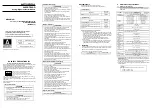
Read the full manual before using this product
5
The above table relates to the multi strand copper cable (for marine applications tinned copper is
recommended). If the cable you intend using is different (such as single strand or aluminium) or you
require distances longer than 4m, please contact your inverter supplier or distributor for advice.
Please note that if there is a problem obtaining, for example, a 90mm
2
cable, you can purchase 2 x
50mm
2
cables or even 3 x 35 mm
2
cables. To use one cable is always preferred but it does not matter
whether one cable or multiple is used, as long as the square areas add up to the same or higher than the
required. The performance of any system can be increased by having thicker and shorter cables, so it is
advised to keep the length as short as possible.
If you can’t source the cable for the inverter locally, your
inverter supplier or distributor should normally be able to offer you this cable.
When connecting the inverter to the battery using the correct heavy duty cable, follow the
guidelines below:
•
Connect the cable though a suitable fuse with an isolator switch, or a circuit breaker. The
minimum current rating of such fuse / switch / circuit breaker depends on the input voltage of your
inverter and the nominal rated power. For example, if your inverter is 3000W 24V, then at nominal
power 3000W it would draw around 3000W / 24V = 125A from the battery. So the fuse / switch or a
circuit breaker should be rated at 125A. This assumes that the inverter is not intended for loads
which will have a peak power in excess of 3000W (in such case the amp rating of the fuse / switch
or a circuit breaker should be higher).
•
The fuse (or a circuit breaker) should be fitted as close to the battery terminal as possible,
ideally within 15cm from it. This way it will protect the full length of cable from the battery to the
inverter from a potential short circuit. In most cases it is installed on the positive cable.
•
After fitting the fuse / switch / circuit breaker, it is advised to connect the cable ends to the
inverter terminals first. Keep the switch or a circuit breaker in Off position. Only after that should
you connect the other end of the cable to the terminals of your battery bank: red positive (+)
terminal of the inverter to the positive (+) of your battery bank, and black negative (-) of the inverter
to the negative (-) of your battery bank.
•
Cables joining batteries in your bank should be similar or thicker than the inverter cables.
WARNING! Do not reverse the polarity of the battery cables. If the battery bank is
connected to the inverter with the wrong polarity, the inverter will be damaged.
The next step is wiring the AC output and AC input of the inverter. Keep the inverter switched off
during this procedure. The overall connection scheme is provided below.
Wiring AC input and output terminals of
LK/LW Series Power Star inverters
Output Input
AC
Power out
AC
Power in
<
<
<
<
<
<
www.ato.com
18005851519
Global Shipping


































